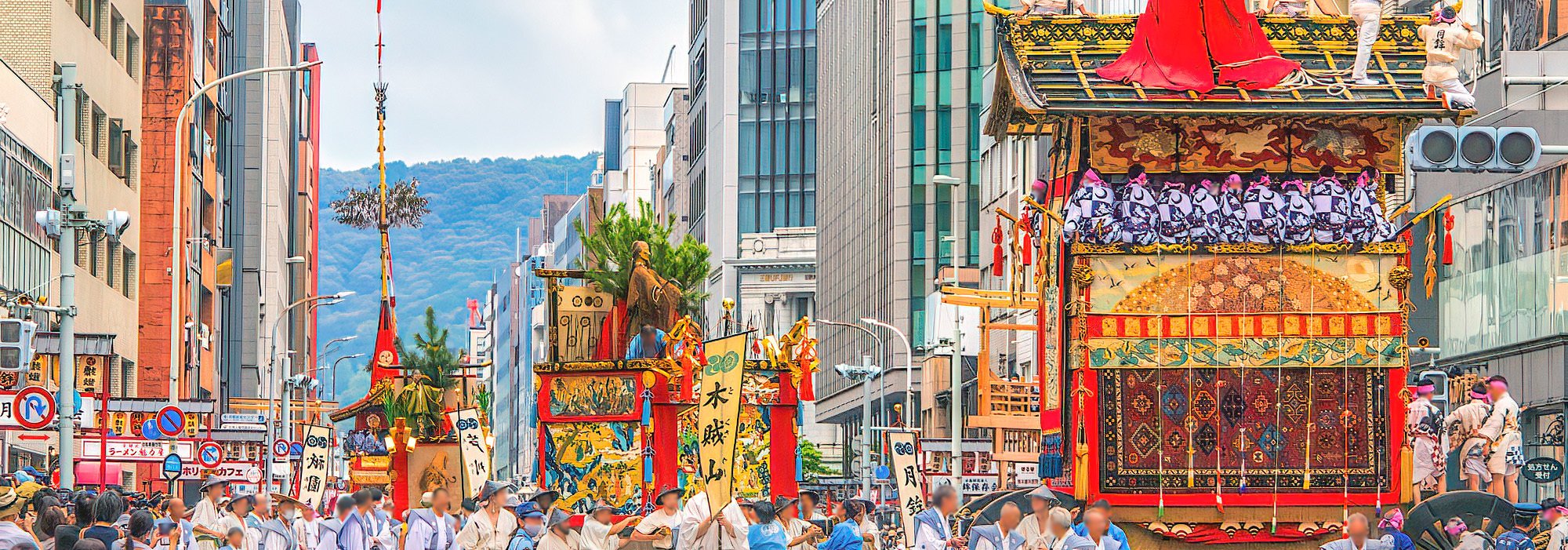The Best Summer Festivals in Japan
by Laura Studarus
From throwing water to galloping horses, here's a few spectacular celebrations.
Summer is a special time in Japan. Not only does the weather warm up—making it a perfect picnic and beach season, but the country hosts a string of festivals, which means that no matter what region you might be visiting, chances are there’s a spectacular piece of culture to enjoy. While every event is different, many have some kind of emphasis on the spiritual realm. July and August are known as the Obon period—a time when the spirits of ancestors are able to visit earth. And what better way to honor them than with a spectacular festival?
While by no means a comprehensive list, here’s a few of our favorite summer festivals from across Japan. These are places where you can experience culture first hand, learn about traditions, and hopefully come away with some incredible photographs and memories. Did we miss any? Let us know!
Gion Matsuri
Gion Matsuri takes place over the entire month of July at the Yasaka Shrine in Kyoto. While there’s plenty to experience, the crowning events are held on July 17 and July 24, when the annual procession of floats (Yamaboko Junko) takes place. The scale is massive, up to 25 meters tall and often weighing 12 tons, pulled on wheels the size of actual people. The same ornate symbolism has been used since 869, when the ceremony was crafted to appease the gods and stop a pandemic. Keep your eyes open for the local boy on the led float. He has been selected to be a divine messenger, and his feet will have not touched the ground from 13th of July until after the parade is completed on the 17th.
Sumidagawa Fireworks Festival
What says summer like a fireworks display? Held every year on the last Saturday of July, Sumidagawa Fireworks Festival is a colorful sign of the season. Established in 1733 in hopes of warding off evil spirits and ending a famine, the event is now considered the oldest fireworks festival in the world. And best of all—you don’t even need to leave Tokyo to get in on the action. The best viewing spot is along the river; however, you can catch the dazzling sight almost anywhere around Tokyo Skytree.
Awa Odori
From August 12 to 15, Japan’s biggest dance festival draws fans from around the world, eager to see the “Fool’s Dance,” a tradition that dates back 400 years. (The name refers to a drunken party, supposedly thrown by a feudal overlord in 1587 to celebrate the completion of his new castle.) In the evening, the streets of downtown Tokushima are blocked for Ren—dance groups from around the world who perform the simple steps while playing traditional instruments. It’s a popular event—so be sure to buy your tickets (2000-6000 yen for a 90-minute block of performances), at 7-11 stores across the country.
Sendai Tanabata Matsuri
According to legend, Tanabata festivals celebrate the moment when the two stars Altair and Vega cross paths. This romantic notation is celebrated August 6-8 at the Sendai Tanabata, when local community groups, shops and schools create bunches of streamers, turning the downtown shopping arcades into colorful fabric forests. This insta-worthy image is accompanied by live music, traditional dances, and food vendors, making it the ultimate hangout spot. To join in, just stroll to Shimin Hiroba Square, around Kotodai Park, and along Jozenji Dori street, where the bulk of the action takes place.
Nebuta Matsuri
Another Tanabata festival is the Nebuta Matsuri in Aomori City, which celebrates this auspicious occasion with large lantern floats, every night from August 2-7. Each lantern is handcrafted over the course of the previous year—and wheeled through the crowd by hand. Participation is highly encouraged—the only requirement for joining the parade is that would-be dancers must wear the traditional haneto dancing costume, which can be purchased at local grocery stores or rented from in-town vendors.
Tenjin Matsuri
Tenjin Matsuri is the festival of light and sky, hosted in Osaka, known as the city of water and light. Every July 24 and 25, attendees enjoy an ornate firework display, boat processions along the Okawa River, and more Taiko-Japanese drum performances than you can shake a bachi sticks. Come early Danjiri Dragon Dance, which signifies the official start of the festival.
Fukagawa Hachiman Matsuri
Fukagawa Hachiman Matsuri is one of Tokyo’s biggest Shinto festivals—and a fun one at that. The mid-August event earned the nickname “water throwing festival,” for the practice of throwing water on the portable shrines carried throughout Tomioka Hachiman-gū shrine district. As if that wasn’t enough encouragement to book a ticket, it’s also home to Japan’s heaviest Mikoshi, a sacred diamond, sapphire, and ruby-covered vehicle thought to transport a deity when moving between shrines.
Sanno Matsuri
Another one of Tokyo’s summer festival gems is Sanno Matsuri, however it’s only held in even number of years—so put this on the calendar for 2024. And pack your walking shoes—the highlight is a nine-hour parade that winds through the streets of Tokyo, beginning and ending at Hie Shrine, which is believed to predate the city. Before you enter, be sure to walk through the straw ring as an act of purification.
Yosakoi Festival
Summer dance fever continues in Kochi with the Yosakoi Festival. Every year from August 9 to 12, over 20,000 dancers descend on the city, each with different colorful costumes and flamboyant chorography. The rules are simple: every dancer must move forward with naruko clappers in their hands—but the variations on how to do it are seemingly endless. If you’re feeling the music, you can join in, every year two teams accept walk-in members.
Akita Kanto Matsuri
Every year from August 3 to 6, Akita City holds the Kanto Matsuri or pole light festival. It is exactly what the name would imply—a spectacularly visual event where performers balance large bamboo poles with an army of paper lanterns on top, all lit by real candles. While the competition is fierce, it’s balanced out each night with a parade, where over 250 poles are carried through the city, creating a spectacular night scene. Think it looks easy? Every day also features a period-when would-be pole lifters can try the artistic sport out for themselves.
Soma Nomaoi Festival
Soma Nomaoi is a thousand-year-old festival celebrating horses and martial arts. Put them together—and you get a spectacular display of strength and skill, held across the last Saturday, Sunday and Monday of July in Minamisoma City, a region known for its horses. There are plenty of events, but the main draw is the Kachu Keiba, a 1,000 race where competitors gallop around the track carrying large, streaming banners, and the Shinki-soudatsusen, where sacred flags are shot into the air to a crowd of waiting riders.





